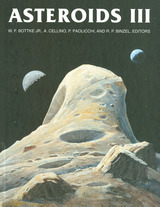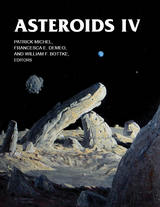2 books about Bottke, William F.

Asteroids III
Edited by W. F. Bottke Jr., A. Cellino, P. Paolicchi, and R. P. Binzel
University of Arizona Press, 2002
Two hundred years after the first asteroid was discovered, asteroids can no longer be considered mere points of light in the sky. Spacecraft missions, advanced Earth-based observation techniques, and state-of-the-art numerical models are continually revealing the detailed shapes, structures, geological properties, and orbital characteristics of these smaller denizens of our solar system. This volume brings together the latest information obtained by spacecraft combined with astronomical observations and theoretical modeling, to present our best current understanding of asteroids and the clues they reveal for the origin an,d evolution of the solar system.
This collective knowledge, prepared by a team of more than one hundred international authorities on asteroids, includes new insights into asteroid-meteorite connections, possible relationships with comets, and the hazards posed by asteroids colliding with Earth. The book's contents include reports on surveys based on remote observation and summaries of physical properties; results of in situ exploration; studies of dynamical, collisional, cosmochemical, and weathering evolutionary processes; and discussions of asteroid families and the relationships between asteroids and other solar system bodies. Two previous Space Science Series volumes have established standards for research into asteroids. Asteroids III carries that tradition forward in a book that will stand as the definitive source on its subject for the next decade.
This collective knowledge, prepared by a team of more than one hundred international authorities on asteroids, includes new insights into asteroid-meteorite connections, possible relationships with comets, and the hazards posed by asteroids colliding with Earth. The book's contents include reports on surveys based on remote observation and summaries of physical properties; results of in situ exploration; studies of dynamical, collisional, cosmochemical, and weathering evolutionary processes; and discussions of asteroid families and the relationships between asteroids and other solar system bodies. Two previous Space Science Series volumes have established standards for research into asteroids. Asteroids III carries that tradition forward in a book that will stand as the definitive source on its subject for the next decade.
[more]

Asteroids IV
Edited by Patrick Michel, Francesca E. DeMeo, and William F. Bottke
University of Arizona Press, 2015
Over the past decade, asteroids have come to the forefront of planetary science. Scientists across broad disciplines are increasingly recognizing that understanding asteroids is essential to discerning the basic processes of planetary formation, including how their current distribution bespeaks our solar system’s cataclysmic past. For explorers, the nearest asteroids beckon as the most accessible milestones in interplanetary space, offering spaceflight destinations easier to reach than the lunar surface. For futurists, the prospects of asteroids as commercial resources tantalize as a twenty-first-century gold rush, albeit with far greater challenges than faced by nineteenth-century pioneers. For humanity, it is the realization that asteroids matter. It is not a question of if—but when—the next major impact will occur. While the disaster probabilities are thankfully small, fully cataloging and characterizing the potentially hazardous asteroid population remains unfinished business.
Asteroids IV sets the latest scientific foundation upon which all these topics and more will be built upon for the future. Nearly 150 international authorities through more than 40 chapters convey the definitive state of the field by detailing our current astronomical, compositional, geological, and geophysical knowledge of asteroids, as well as their unique physical processes and interrelationships with comets and meteorites. Most importantly, this volume outlines the outstanding questions that will focus and drive researchers and students of all ages toward new advances in the coming decade and beyond.
Asteroids IV sets the latest scientific foundation upon which all these topics and more will be built upon for the future. Nearly 150 international authorities through more than 40 chapters convey the definitive state of the field by detailing our current astronomical, compositional, geological, and geophysical knowledge of asteroids, as well as their unique physical processes and interrelationships with comets and meteorites. Most importantly, this volume outlines the outstanding questions that will focus and drive researchers and students of all ages toward new advances in the coming decade and beyond.
[more]
READERS
Browse our collection.
PUBLISHERS
See BiblioVault's publisher services.
STUDENT SERVICES
Files for college accessibility offices.
UChicago Accessibility Resources
home | accessibility | search | about | contact us
BiblioVault ® 2001 - 2024
The University of Chicago Press









